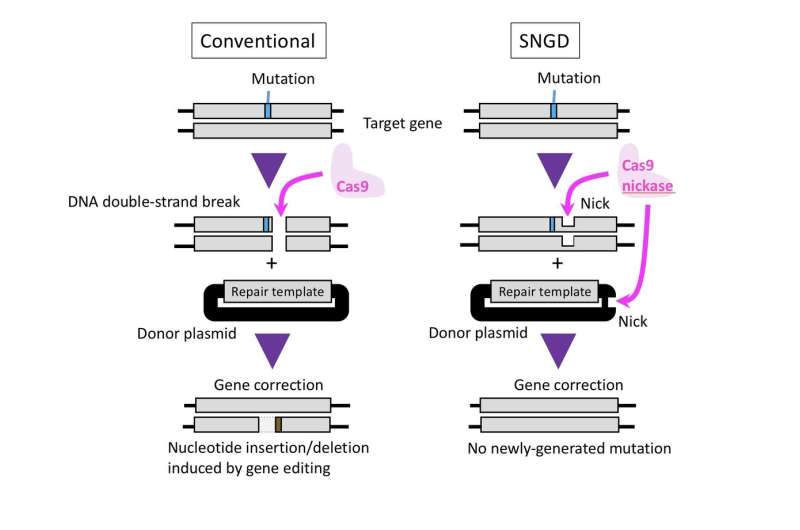New genome-editing method 'cuts back' on unwanted genetic mutations

Gene therapy is an emerging strategy to treat diseases caused by genetic abnormalities. One form of gene therapy involves the direct repair of a defective gene, using genome-editing technology such as CRISPR-Cas9. Despite its therapeutic potential, genome editing can also introduce unwanted and potentially harmful genetic errors that limit its clinical feasibility. In a study published in Genome Research, researchers centered at Osaka University report the use of a modified version of CRISPR-Cas9 that can edit genes with substantially fewer errors.
CRISPR-Cas9 works through the combined action of the Cas9 protein, which cuts DNA, and a short guiding RNA (sgRNA), which tells Cas9 where to make the cut. Together, these two molecules allow virtually any gene in the genome to be targeted for editing. The greater challenge, though, is finding a way to make specific changes to a gene once it has been targeted.
"Cas9 cleaves DNA on both of its strands, essentially splitting the target gene in two," principal investigator Shinichiro Nakada explains. "The cell tries to repair the damage by ligating the two pieces back together, but the end result is imprecise and often leaves unintended mutations."
Cells have a precise form of repair that uses donor DNA as a template to correct damage. The template acts as a molecular blueprint, allowing the cell to repair DNA with much greater accuracy. Importantly, by giving cells a different blueprint-in other words, by introducing foreign donor DNA into a cell-highly accurate edits can be made to a defective gene.
"The problem is that Cas9 cleavage is rarely repaired by the precise route," Nakada adds. "We instead used a modified Cas9 that only 'nicks' DNA in one strand, rather than cutting both strands. We discovered that when we nick both the target gene and donor DNA, we can essentially commandeer precise repair to make exact changes to the target gene."
The researchers found that the nicking technique, which they term Single Nicking in the target Gene and Donor (SNGD), greatly suppresses the rate of unintended genetic mutation compared with the conventional method. In one experiment, the standard technique made potentially-harmful errors over 90% of the time, while SNGD did so less than 5% of the time. Importantly, this precision did not impair the overall performance of the approach, which was able to efficiently achieve the desired genetic edits.
"Our study is a proof of principle that target-donor nicking can achieve accurate genome editing without DNA cleavage, which has significant implications for its use in medicine," Nakada notes. "There are many diseases for which a precise Cas9 system like this would make gene therapy more cost-effective and safer. We are very excited to see how this technique will be incorporated into the current paradigm of gene editing technologies."
More information: Kazuhiro Nakajima et al. Precise and efficient nucleotide substitution near genomic nick via noncanonical homology-directed repair, Genome Research (2017). DOI: 10.1101/gr.226027.117
Journal information: Genome Research
Provided by Osaka University




















